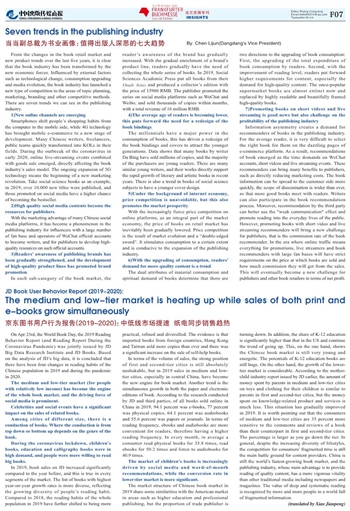On Apr 23rd, the World Book Day, the 2019 Reading Behavior Report (and Reading Report During the Coronavirus Pandemic) was jointly issued by JD Big Data Research Institute and JD Books. Based on the analysis of JD’s big data, it is concluded that there have been four changes in reading habits of the Chinese population in 2019 and during the pandemic in 2020.
The medium and low-tier market (for people with relatively low income) has become the engine of the whole book market, and the driving force of social media is prominent.
Celebrities and social events have a significant impact on the sales of related books.
Among cities of different size, there is a conduction of books. Where the conduction is from top down or bottom up depends on the genre of the book.
During the coronavirus lockdown, children’s books, education and calligraphy books were in high demand, and people were more willing to read big books.
In 2019, book sales on JD increased significantly compared to the year before, and this is true in every segments of the market. The list of books with highest year-on-year growth rates is more diverse, reflecting the growing diversity of people’s reading habit.Compared to 2018, the reading habits of the whole population in 2019 have further shifted to being more practical, refned and diversifed. The evidence is that imported books from foreign countries, Hong Kong and Taiwan sold more copies than ever and there was a signifcant increase on the sale of self-help books.
In terms of the volume of sales, the strong position of first and second-tier cities is still absolutely unshakable, but in 2019 sales in medium and low-tier cities, especially in central China, have become the new engine for book market. Another trend is the simultaneous growth in both the paper and electronic editions of book. According to the research conducted by JD and third parties, of all books sold online in China in 2019, 94.1 percent was e-books, 77 percent was physical copies, 64.1 percent was audiobooks and 55.6 percent was papers or journals. In terms of reading frequency, ebooks and audiobooks are more convenient for readers, therefore having a higher reading frequency. In every month, in average a consumer read physical books for 35.8 times, read ebooks for 50.2 times and listen to audiobooks for 40.9 times.
The market of children’s books is increasingly driven by social media and word-of-mouth recommendations, while the conversion rate in lower-tier market is more signifcant.
The market structure of Chinese book market in 2019 share some similarities with the American market in areas such as higher education and professional publishing, but the proportion of trade publisher is turning down. In addition, the share of K-12 education is signifcantly higher than that in the US and continue the trend of going up. This, on the one hand, shows the Chinese book market is still very young and energetic. The potentials of K-12 education books are still huge. On the other hand, the growth of the lower-tier market is considerable. According to the mother-child industry report issued by JD earlier, the amount of money spent by parents in medium and low-tier cities on toys and clothing for their children is similar to parents in first and second-tier cities, but the money spent on knowledge-related product and services is much less. This situation has gradually improved in 2019. It is worth pointing out that the consumers of medium and low-tier cities are 35 percent more sensitive to the comments and reviews of a book than their counterpart in first and second-tier cities. The percentage is larger as you go down the tier. In general, despite the increasing diversity of lifestyles, the competition for consumers’ fragmented time is still the main battle ground for content providers. China is still the world’s fastest-growing book market, and the publishing industry, whose main advantage is to provide reading of quality content, has a more vigorous vitality than other traditional media including newspapers and magazines. The value of deep and systematic reading is recognized by more and more people in a world full of fragmented information.
(translated by Xiao Jianpeng)


